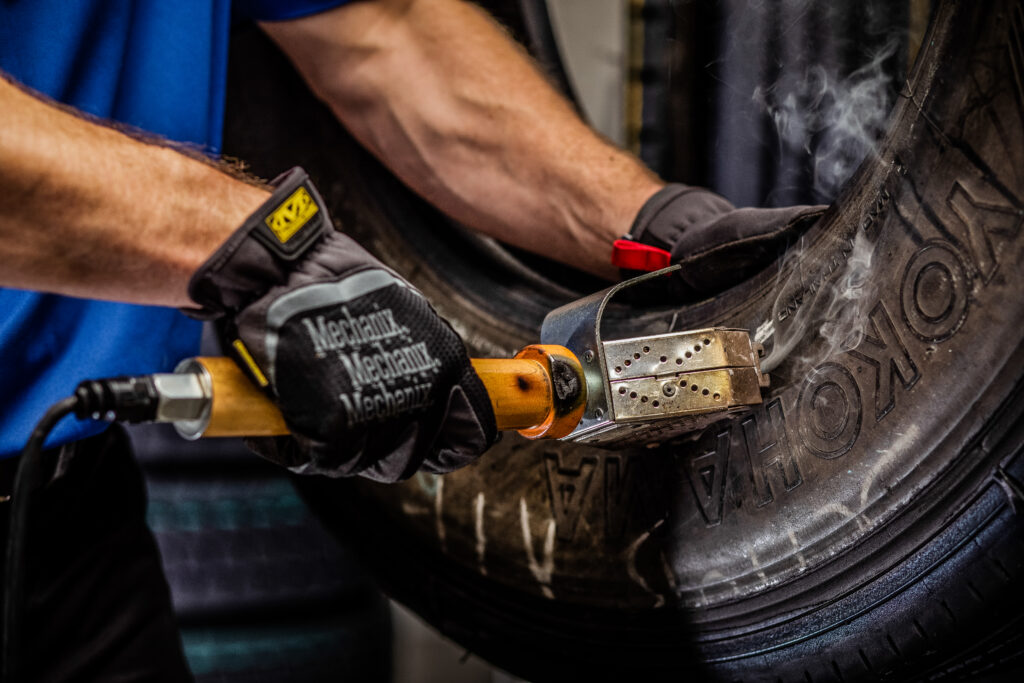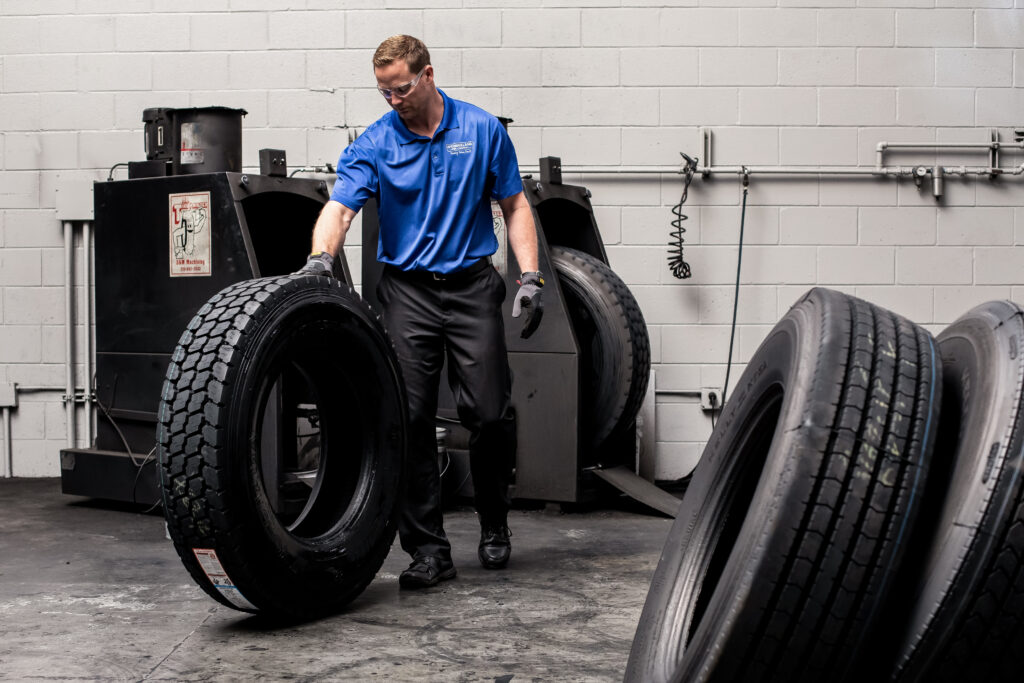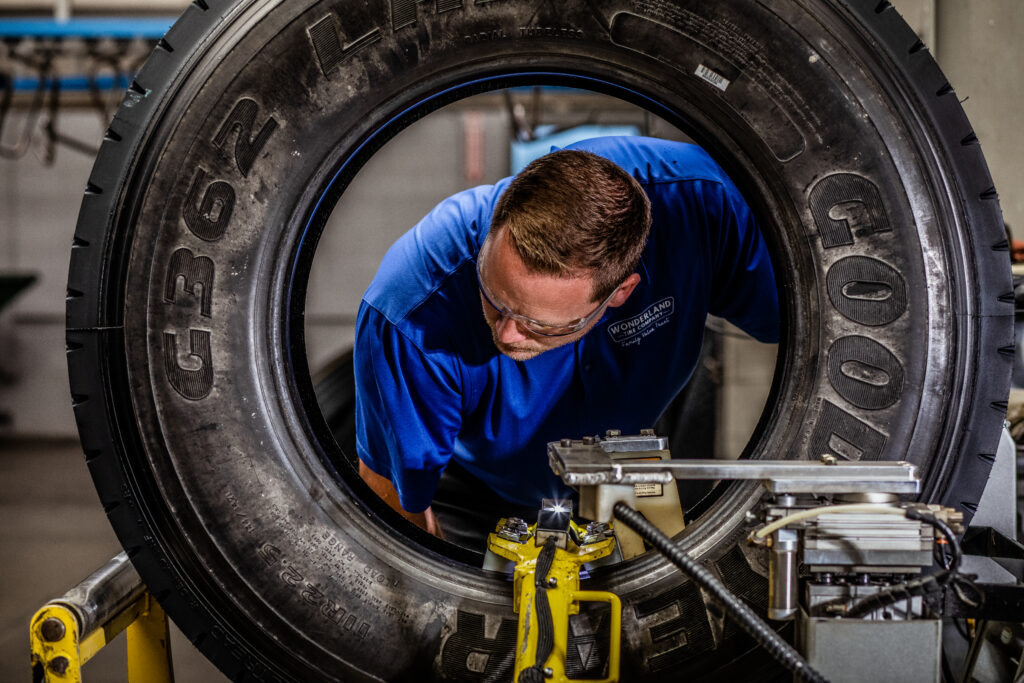Did you know that retreading your tires multiple times can give them a lifetime of up to 600,000 miles? Tire retreading not only maximizes a tire’s lifespan, but also lowers overall costs and maintains the original investment for fleet owners of commercial long-haul, short-haul, and off-road vehicles alike. But how many times can a tire be retreaded?
This blog outlines:
- How Many Times Can a Tire Be Retreaded?
- Factors That Determine How Many Times You Can Retread
- Maintaining Your Retreads
- Frequently Asked Questions
- The AcuTread® Difference
How Many Times Can a Tire Be Retreaded?
How many times a tire can be retreaded depends on the application and use of the tire. For example, long-haul fleets tend to retread their tires 2-3 times while short-haul, local service fleets can retread their tires 5 times or more with proper maintenance.
However, several other factors can influence how many times your tires can be retreaded.

Factors That Determine How Many Times You Can Retread
Tire Casing Quality
Whether or not your tire can be retreaded relies solely on the quality of your tire casing. It takes a quality casing to produce a quality remanufactured tire—one that can continue to be retreaded once more.
Casing Age
If your tire is 7 years or older, it is most likely out of the running for retreading. However, this can be extended to 10 years if the casing being retreaded is for local use. Because the age of your tire often correlates to the strength and durability of your tire casing, the older your tire gets, the fewer retreading life cycles it has left. However, a thorough inspection will determine the tire’s condition and see if its casing is strong enough to retread.
Tire Maintenance
Wear and stress can also negatively affect the strength of your tire casings, regardless of age. For example, if your tires constantly undergo strenuous working conditions or are poorly maintained, the casing will wear faster, reducing the number of times it can be retreaded in the future. Consistently maintaining the correct air pressure of your tires for the speeds being driven and the weights being put on them is the single most important maintenance factor in casing longevity.
Application
Because different applications undergo different levels of stress and wear, the number of times a tire can be retreaded ranges. Long-haul applications can often be retreaded only 2-3 times because tire casings wear out faster under high-speed stress. However, short-haul applications that don’t experience as much tire casing stress can often be retreaded 5-6 times.

Maintaining Your Retreads
You should maintain your remanufactured tires in the same way you would maintain new tires. Just follow these simple recommendations:
Proper Tire Inflation
One of the best ways to maximize the retreadability and durability of your tire casings is to maintain proper tire inflation pressure. Over-inflating can wear out the center of the tread while under-inflating can wear out the tire’s shoulder and damage the casing’s structure.
Rotate Your Tires Regularly
Periodical tire rotations help to even out tire wear, extending their lifespan and maintaining their integrity for future retreads.
Check Your Vehicle’s Alignment
Misaligned tires can shorten the lifespan of your remanufactured tires. A good indicator that your tires are misaligned is irregular tread wear. For more information on identifying irregular wear on commercial vehicles, read Irregular Wear Patterns: A Guide to Checking Your Commercial Steer Tires and What Causes My Commercial Trailer Tires to Wear Irregularly on the Inside Edge?
Take Care of Your Current Tread
Clean Your Tread
Premature tire wear is often caused by hazards such as salt, chemicals, and debris like nails and glass. Washing your tires anytime you wash your truck is a good way to combat those hazards along with regular damage inspections before and after each trip.
Drive Carefully
Aggressive starting, stopping, turning, and speeding can cause excessive wear on your tires, along with other truck components. Making sure you are driving carefully is another great way to combat premature tread wear and protect your tire casings.
Watch Your Treadwear
The minimum allowable tread depth for retreading is 4/32” (for steer tires) and 2/32” (for drive and trailer tires). Allowing the tread to get any lower than this will only increase the likelihood of causing damage and disqualify them for retreading.
Learn more about protecting your current tire casings.
Frequently Asked Questions
How long does a retread tire last?
A retread tire can last as long as, or longer than, new tires, depending on how many miles you put in. Of course, proper inflation and regular maintenance are key to extending your remanufactured tires’ life and raising their chances of being retreaded once more.
Are retread tires as good as new?
Retreaded tires can be just as good, if not better than new, depending on the retreading process. At AcuTread, our remanufacturing process meets the same standards as the original tire manufacturing process and follows many of the same steps. In addition, our retreaded tires are manufactured with only certified materials and undergo multiple vigorous inspections.
For more information, Wonderland Tire, a co-developer of the AcuTread® process, answers the question “Are Retreads Safe?” in their guide to retreads and their benefits.
Can old tires be retreaded?
Tires that have reached seven years or more of active performance are typically considered unsafe to retread for long-haul over-the-road semi-truck and trailer applications. However, casings older than that can be retreaded for local and regional haul applications in industries like construction and local pickup and delivery.

The AcuTread® Difference
Wondering if your tires are suitable for retreading? Get in touch! When you choose AcuTread, a trained inspection technician will evaluate your tires for specific conditions that either qualify or disqualify your casings for the possibility of retread.
The AcuTread® remanufacturing process is a highly advanced retreading system, engineered second to none. It allows us to produce tires that are built expertly for safety, uniformity, reduced heat buildup, and longer tread life.
Interested in retreading your tires with an AcuTread manufacturer? Find an AcuTread dealer near you.


